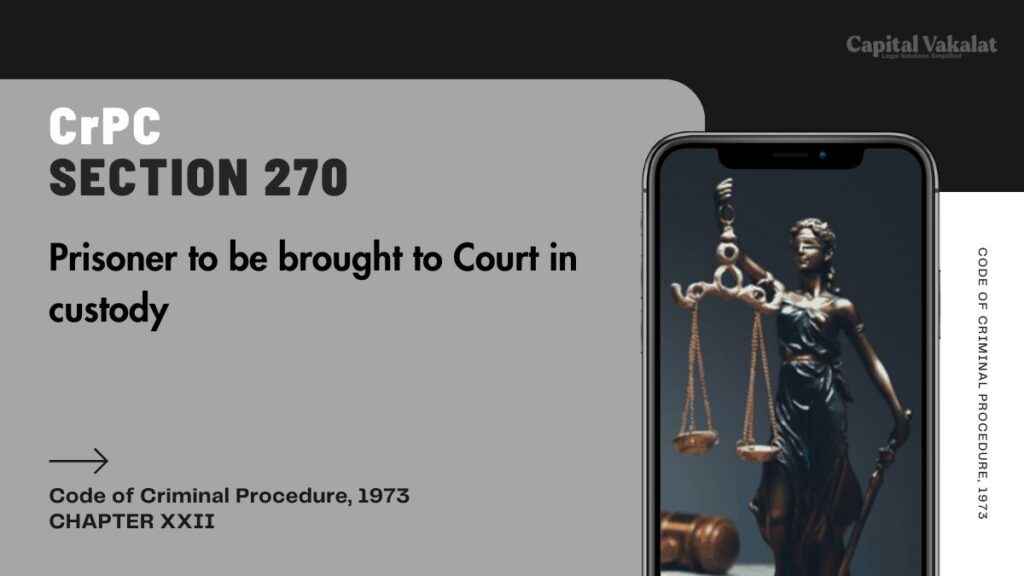Section 270 of the Criminal Procedure Code (CrPC) in India is a crucial legal provision that ensures the appearance of prisoners in court. This section mandates that any person in custody must be brought to court when their presence is required.

This legal requirement underscores the importance of ensuring justice is served while protecting the rights of the accused.
Bare Act. Section 270 Cr.P.C.
Prisoner to be brought to Court in custody.
Subject to the provisions of section 269, the officer in charge of the prison shall, upon delivery of an order made under sub-section (1) of section 267 and duly countersigned, where necessary, under sub-section (2) thereof, cause the person named in the order to be taken to the Court in which his attendance is required, so as to be present there at the time mentioned in the order, and shall cause him to be kept in custody in or near the Court until he has been examined or until the Court authorises him to be taken back to the prison in which he was confined or detained.
Historical Context of Section 270 CrPC
The Criminal Procedure Code, originally enacted in 1973, has undergone numerous amendments to reflect the changing dynamics of criminal justice in India. Section 270 CrPC was instituted to address the challenges of ensuring prisoner appearances in court, a fundamental aspect of fair trials. Historically, this provision emerged from the necessity to maintain the integrity of legal proceedings and safeguard the rights of prisoners.
Key Provisions of Section 270 CrPC
Section 270 CrPC specifically states that any person in custody must be brought to court to answer charges or for any other legal purpose. The provision highlights the responsibility of the state to ensure that prisoners are transported safely and securely to courtrooms. This section applies to all prisoners, regardless of the nature of their crime or the stage of their trial.
The Legal Implications of Section 270 CrPC
The implementation of Section 270 CrPC carries significant legal implications. Firstly, it upholds the principle of natural justice by ensuring that the accused has the opportunity to be heard in court. Secondly, it mandates the logistical and administrative processes required to transport prisoners, involving coordination between police, prison authorities, and the judiciary.
Ensuring Prisoner Rights under Section 270 CrPC
Section 270 CrPC also serves as a safeguard for prisoner rights. It ensures that prisoners are not deprived of their right to be present during their trial, a fundamental aspect of legal proceedings. This provision protects against potential abuses and ensures that prisoners are treated with dignity and respect throughout the judicial process.
Challenges in Implementing Section 270 CrPC
Despite its importance, the implementation of Section 270 CrPC faces several challenges. Logistics and security concerns often complicate the transportation of prisoners to court. Additionally, the administrative burden on law enforcement and judicial authorities can be substantial, requiring meticulous planning and coordination.
The Role of Technology in Facilitating Court Appearances
With advancements in technology, some jurisdictions have explored virtual court appearances as an alternative to physical transportation. Video conferencing can mitigate the challenges associated with prisoner transportation, ensuring timely court appearances while maintaining security. However, the implementation of such measures must be balanced with the need to preserve the rights and dignity of the accused.
Case Studies Highlighting Section 270 CrPC
Numerous case studies highlight the application and impact of Section 270 CrPC. For instance, in high-profile cases involving serious crimes, ensuring the safe and timely appearance of the accused in court is critical. These cases underscore the importance of meticulous planning and coordination among various agencies to uphold the provisions of Section 270 CrPC.
The Future of Section 270 CrPC
Looking ahead, the future of Section 270 CrPC will likely involve a blend of traditional practices and modern technological solutions. As the legal system continues to evolve, ensuring the fair treatment of prisoners while maintaining the efficiency of court proceedings will remain a priority. Ongoing reforms and innovations will play a crucial role in shaping the implementation of this critical legal provision.
Conclusion
Section 270 CrPC is a pivotal aspect of the Indian legal system, ensuring that prisoners are brought to court in custody for fair trial proceedings. This provision underscores the importance of maintaining justice and protecting the rights of the accused. Despite the challenges, ongoing reforms and technological advancements hold promise for enhancing the implementation of this critical legal requirement. Upholding the principles enshrined in Section 270 CrPC will continue to be a cornerstone of the Indian judiciary, reflecting the nation’s commitment to justice and human rights.